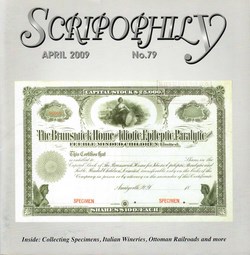
This article appeared in
SCRIPOPHILY
April, 2009r
Scripophily is a member benefit of
the International Bond & Share Society.
Visit the IBSS website for info.
Cancellations
Cancellation is a method of preventing documents to be used more than once for their original intended purposes. Documents can range from movie tickets to checks to paper money to securities. There are two main categories of cancellation representing either the addition of something to documents or disrupting paper surfaces.
Additive types of cancellation include handwriting, rubber stamp impressions, typewritten or printed notices. Disruptive types of cancellations can range from tearing documents in half (movie tickets, for instance) to punching holes, impressing designs, impaling on spikes or cutting them in some manner. Regardless of methods, cancellations are meant to make documents non-negotiable.
Because stocks and bonds represented large sums of money, cancellation has always been very important to companies. The oldest and most obvious ways of cancelling certificates was to write “cancelled” across the bodies of certificates. Pen cancellation (including crayons and china markers) has been around since the very first certificates. As long as the number of certificates cancelled each day was limited, there was no need for more elaborate methods.
Companies moved to time-saving methods of cancellation once they grew to the point where they needed to transfer more than a handful of certificates each week. Mechanical punch cancellations started appearing in the 1840s, but gained popularity among larger companies by the mid-1850s. Punch cancellations generally consisted of series of single holes punched by hand devices similar to those used to cancel train tickets. Cancellations were generally circular holes, 2mm to 5mm diameter, punched through signatures. Hole shapes and sizes became more diverse by the 1870s. Punches in the shapes of single letters were popular among some companies by the end of the 1900s.
Cancellation using rubber stamps was another obvious time-saving approach. The earliest rubber stamp cancellations on stock certificates appeared in the early 1850s, within only six or seven years of Charles Goodyear’s rubber vulcanization patent.
“Pinhole” cancellations are elaborate variations of hand punches and seem to have appeared in the early 1870s. These cancellations consisted of series of tiny holes organized into words, dates and abbreviations. Rotary punch devices also appeared in the 1870s and removed lines of circular punch holes in one smooth, efficient motion. “Machine-gun” cancellations like this were unpopular on stock certificates, but were used quite frequently for bonds.
Like bank checks, a small number of stock certificates were cancelled by impaling them on spindles or by cutting them with series of triangular, X-shaped or concentric knives. Cut and spindle cancellations are almost impossible to research because they leave little evidence in photos and scans. Huge numbers of Chicago Burlington & Quincy certificates were cut with three V-shaped knives, but essentially none of the damage shows up in photos.
For some reason, a few companies took more destructive approaches and removed large pieces of paper, either from the bottom edges of certificates or from the signature areas. Quintessential examples of such cancellations can be seen among certificates of the Louisville & Northern Railway & Lighting Co. I have never found any published explanation for such paranoid approaches.
A few months ago, I wondered if there were trends among the various methods of cancellation, either date-wise or population-wise. The problem with discovering date trends is that hardly anyone ever reports the dates certificates were cancelled. There is often no way to tell if investors owned certificates for days or decades. We can, however, see trends among populations of cancelled stock certificates. (I plan to research bond cancellations later this year.)
While pen cancellations have been used for about 170 years, hand punch cancellations affect 58% of all issued and cancelled stock certificates. Rubber stamp cancellations are the second most popular method (41%) followed by pen (32%) and pinhole cancellations (17%). Potentially large, but unknown, numbers of cut and spindle cancellations probably exist, but are undercounted because they are invisible in photographs.
The most surprising observation I have found so far is the percentage of certificates cancelled by multiple methods. Counting only issued stock certificates, 46% of all cancelled shares were cancelled by two or more methods – usually hand punches combined with rubber stamp impressions. Almost 9% of all certificates were cancelled by three or more methods.
I suspect multiple cancellation methods represent error checking and accounting redundancy. As I tallied cancellations, I concluded that the majority of cancellations can probably be attributed to trust companies. Once trust companies and clearing houses became involved in transferring certificates, it appears certificates moved through the hands of more and more clerks, each applying distinct cancellations and marks. Many certificates show two, three and sometimes four different punch cancellations, easily identified by distinct shapes and sizes.
Collectors know the obvious relationships between cancellations and prices. While there are occasional exceptions, uncancelled certificates are worth the most. Certificates with typical cancellations are less expensive. Certificates with large cutout cancellations are the cheapest. Beyond that, however, there are no predictable penalties or premiums for methods of cancellation or degrees of cancellation. Individual collectors have definite preferences, but considered as a whole, lightly cancelled certificates tend to sell for approximately the same as heavily cancelled examples.